Innovative approaches of professional music education in studying rhythmics
Abstract
The article is dedicated to the innovative project of modern music education, on the study of rhythm, where musical rhythm is the architectonics of the emotional and rhythmic-intonational expression of a professional performer.
In contrast to the traditional methods of studying rhythmics, where a limited amount of material is devoted to the knowledge of rhythm, a new form of ideas regarding the modelling of rhythmic sequences in the time continuum is proposed, based on the author's development of Stanislav Makievsky, which he called the «perforation method». The technology of this method is «know-how» and offers to expand the understanding of musical rhythm, through a deep understanding of the essence of the rhythm-intonation process. Such a novelty of the methodical approach consists in the analytical understanding of performance skill from the point of view of the aesthetics of metro rhythmic combinations, planning and fixing them in the motor memory of the performer, which lays the foundation for the training course «Rhythmic Vocalist. Professional Course», written in co-authorship with Stanislav Makievsky and published by a separate educational and methodological publication.
The manual proposes to expand the idea of rhythmicity as a multifunctional musical-aesthetic system through such components as biomotor activity of the organism, its role in synchronization (conducting several processes to a coordinated action). The development of the basic principles of rhythmic sound control is formed in direct connection with the ascending (arsis) and descending (thesis) movements of the hands, which is included in the single concept of «synchronization» and for the first time is considered as the details of a single process (positional articulation of the hands). Thematic lessons are provided with video and audio information, presented in a supplement to the course, as well as a short glossary of rhythmic terms, that are most commonly used in variety music. The final part of the training course presents material for a comparative analysis of A. Mansanero's song «Somos novios» performed by A. Bocelli and P. Como and a brief description of the rhythmic aesthetics of each artist's style.
The name of the course has a symbolic meaning, which refers to the oldest instruments of human civilization ‒ percussion and voice (vocals). Thus, the innovation of this rhythmic development emphasizes its universality, which is not limited by age categories or musical specialty.
References
Самая Т., Макієвський С. Ритміка вокаліста. Професійний курс. Київ: 7БЦ, 2021. 60 с.
Самая Т. Особливості музичного метроритму у естрадному вокальному виконавстві. Арт-Платформа. 2020. №2. Сс. 366-385.
Andrea Bocelli. Somos Novios. Live From Castagneto Carducci, Italy. 2001.
URL: https://www.youtube.com/watch?v=Qq0I0x__U-g.
Mackinnon L. Music by Heart. Westport, CT: Greenwood Press, 1981. 141 p.
Perry Como. It’s Impossible. URL: https://www.youtube.com/watch?v=BKQ9--_ZgB4.

 ISSN
ISSN  ISSN
ISSN 



